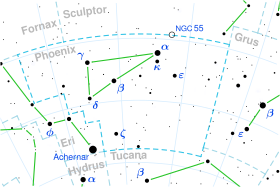
Back Nu Phoenicis AST Ni del Fènix Catalan Ni Phoenicis Spanish نو ققنوس Persian Nu Phoenicis French Nu Phoenicis ID Nu Phoenicis Italian ほうおう座ニュー星 Japanese 봉황자리 뉴 Korean Nu Phoenicis Dutch
| Observation data Epoch J2000 Equinox J2000 | |
|---|---|
| Constellation | Phoenix |
| Right ascension | 01h 15m 11.12150s[1] |
| Declination | –45° 31′ 53.9954″[1] |
| Apparent magnitude (V) | 4.95[2] |
| Characteristics | |
| Spectral type | F9 V Fe+0.4[3] |
| U−B color index | +0.09[2] |
| B−V color index | +0.57[2] |
| Astrometry | |
| Radial velocity (Rv) | +11.82 ± 0.15[4] km/s |
| Proper motion (μ) | RA: 664.28[4] mas/yr Dec.: 179.06[4] mas/yr |
| Parallax (π) | 65.8894 ± 0.1803 mas[4] |
| Distance | 49.5 ± 0.1 ly (15.18 ± 0.04 pc) |
| Absolute magnitude (MV) | 4.07[5] |
| Details[5] | |
| Mass | 1.17 M☉ |
| Radius | 1.26 ± 0.04 R☉ |
| Luminosity | 2.0 ± 0.1 L☉ |
| Surface gravity (log g) | 4.31 ± 0.10 cgs |
| Temperature | 6,066 ± 70 K |
| Metallicity [Fe/H] | +0.16 ± 0.06 dex |
| Rotational velocity (v sin i) | 3.7 ± 0.5 km/s |
| Age | 4.2[6] Gyr |
| Other designations | |
| Database references | |
| SIMBAD | data |
Nu Phoenicis is a F-type main-sequence star in the southern constellation of Phoenix. It is visible to the naked eye with an apparent visual magnitude of 4.95.[2] This is a solar analogue, meaning its observed properties appear similar to the Sun, although it is somewhat more massive. At an estimated distance of around 49.5 light years,[4] this star is located relatively near the Sun.
Based on observations of excess infrared radiation from this star, it may possess a dust ring that extends outward several AU from an inner edge starting at 10 AU.[8]
- ^ a b Cite error: The named reference
aa474_2_653was invoked but never defined (see the help page). - ^ a b c d Cite error: The named reference
MERMILLIODwas invoked but never defined (see the help page). - ^ Cite error: The named reference
Gray2006was invoked but never defined (see the help page). - ^ a b c d e Brown, A. G. A.; et al. (Gaia collaboration) (August 2018). "Gaia Data Release 2: Summary of the contents and survey properties". Astronomy & Astrophysics. 616. A1. arXiv:1804.09365. Bibcode:2018A&A...616A...1G. doi:10.1051/0004-6361/201833051.
- ^ a b Cite error: The named reference
Fuhrmann2017was invoked but never defined (see the help page). - ^ Cite error: The named reference
Casagrande2011was invoked but never defined (see the help page). - ^ Cite error: The named reference
SIMBADwas invoked but never defined (see the help page). - ^ Cite error: The named reference
Beichman2006was invoked but never defined (see the help page).
